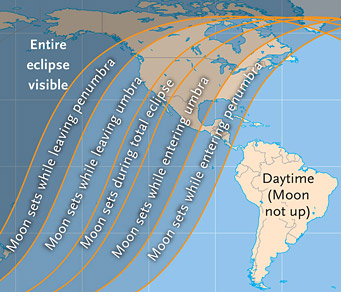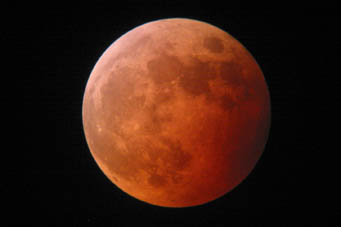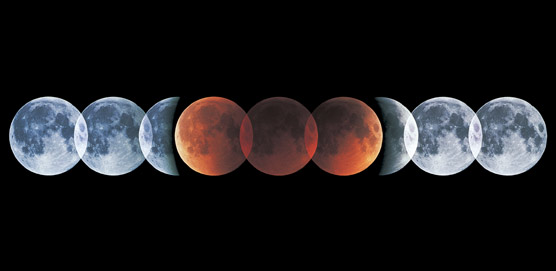Contact:
Alan MacRobert, Senior Editor
855-638-5388 x2151, [email protected]
Note to Editors/Producers: This release is accompanied by high-quality graphics; see the end of this release.
For more information and a map of the eclipse's visibility, please direct your readers/viewers to our online story about the eclipse.
If you're anywhere in central or western North America, mark your calendar to get up before dawn this Saturday, December 10, 2011. That morning the full Moon goes through its last total eclipse until 2014.
The farther west you are in the U.S. or Canada, the better you'll be set up for the show. If you're in the Pacific time zone you can watch the Moon slip into Earth's shadow completely, while the Moon is sinking low in the west-northwestern sky and dawn is brightening. In the Pacific Northwest and westernmost Canada, you can even see the Moon start to emerge from our planet's shadow after the total eclipse is over — until moonset and sunrise end the show.

How much of the dawn lunar eclipse will be visible for you? For your location, this map tells what stage the eclipse will have progressed to by the time the Moon sets below your west-northwestern horizon.
The Sun rises right around the same time an eclipsed Moon sets. This means the sky will have been growing brighter and brighter up to then. (Dawn begins about an hour and a half before sunrise).
Click image for larger view. Free to reproduce if Sky & Telescope is credited. Online use must include a link to SkyandTelescope.com.
Here is a whole-world map showing the eclipse circumstances worldwide.
Sky & Telescope magazine
From roughly Arizona to the Dakotas, the Moon sets while it's still totally eclipsed — though horizon obstructions and the brightening dawn may end your view somewhat before then.
In the Central time zone the Moon sets while still only partially eclipsed, before the total stage even begins. And those farther east miss out completely.
Skywatchers in Hawaii, Australia, and East Asia have it better. Seen from there, the whole eclipse happens high in a dark sky from start to finish. For Europe and Africa, the eclipsed Moon will be lower in the east during or after twilight on the evening of the 10th.
Unlike an eclipse of the Sun, an eclipse of the Moon is visible to everyone on the entire Moon-facing side of the world at once. “We’re all looking at this together,” says Sky & Telescope senior editor Alan MacRobert.
The eclipse will be total from 6:05 to 6:57 a.m. Pacific Standard Time, as shown in the table below. The partial stage of the eclipse begins more than an hour earlier.
When the Moon is totally eclipsed, it glows eerily orange, red, or dark bloody brown. Although the Moon is completely inside Earth's shadow, it's still dimly lit by sunlight that skims the edge of Earth and is refracted (bent) into Earth's shadow by the atmosphere.
“That red light on the Moon during a lunar eclipse comes from all the sunrises and sunsets around the Earth at the time,” explains S&T editor in chief Robert Naeye. “If you were an astronaut standing on the Moon and looking up, the whole picture would be clear. The Sun would be covered up by a dark Earth that was ringed all around with a thin, brilliant band of sunset- and sunrise-colored light, bright enough to dimly light the lunar landscape around you.”
| December 10th's Total Lunar Eclipse | ||||
| Event | UT | CST | MST | PST |
| Partial eclipse begins | 12:45 | 6:45 a.m. | 5:45 a.m. | 4:45 a.m. |
| Total eclipse begins | 14:05 | — | 7:05 a.m. | 6:05 a.m. |
| Mid-eclipse | 14:32 | — | 7:32 a.m. | 6:32 a.m. |
| Total eclipse ends | 14:57 | — | 7:57 a.m. | 6:57 a.m. |
| Partial eclipse ends | 16:18 | — | — | — |
During this eclipse, the Moon barely skims inside the southern side of Earth's shadow. So we can expect the Moon's southern rim to remain brighter than the rest — creating a lovely 3-D effect and drama for photographers. To get a good image scale, use a long telephoto lens or even a small telescope.
Next eclipses
The next eclipse of the Moon will be only partial, happening before and during dawn on June 4, 2012. It will be visible from most of North America except the Northeast.
The next total lunar eclipse doesn't come until the night of April 14-15, 2014. But then the Moon will be positioned high in a dark sky for viewers all across the Americas.
For more skywatching information and other astronomy news, visit SkyandTelescope.com or pick up Sky & Telescope, the essential magazine of astronomy since 1941.
Sky & Telescope is making the following photographs available to editors and producers. Permission is granted for one-time, nonexclusive use in print and broadcast media, as long as appropriate credits (as noted) are included. Web publication must include a link to SkyandTelescope.com.

Taking a break from Game 4 of the World Series on October 27, 2004, Sky & Telescope editor in chief Rick Fienberg snapped this view of that evening's total eclipse of the Moon. Click on the image for a larger version.
Sky & Telescope photo by Richard Tresch Fienberg

Aligning his camera on the same star for nine successive exposures, Sky & Telescope contributing photographer Akira Fujii captured this record of the Moon”™s progress dead center through the Earth”™s shadow in July 2000. This image is available as a publication-quality JPEG (1.5 megabytes).
Sky & Telescope / Akira Fujii
 0
0
Comments
You must be logged in to post a comment.